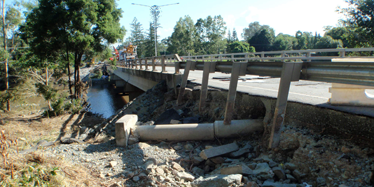Road repairs in emergencies and natural disasters

In an emergency or natural disaster (such as a cyclone, storm, bushfire, tsunami or flood), roads may be closed or restricted (for example, weight limits might be placed on them).
This might be because the roads are:
- damaged
- blocked
- unsafe
- needed for emergency vehicles.
You may not be able to use these roads until they are:
- checked by a road engineer
- cleared
- fixed
- no longer needed for emergency vehicles.
It’s not always easy to see damage and dangers. For example, a road may look safe to drive on but the soil or clay underneath it might be wet and boggy. A bridge may look clear of floodwater but it might still be wet and holding a lot of weight or damaged underneath and not safe to use.
You must always abide by road closures and restrictions—they are there to keep you safe.
Signs and markers
To make sure you drive safety and correctly in, and soon after, emergencies and natural disasters, you must know the:
- flood barriers and signs
- road closure signs
- roadworks signs
- guide and information signs
- warning signs
- regulatory signs
- hazard markers.
More information about road signs.
Road closure information
If you need to head out on the road in, or soon after, an emergency or natural disaster you should carefully plan your route before leaving. Your normal routes may be blocked, closed, or put you in danger.
QLDTraffic provides real-time details of road closures and restrictions across Queensland.
You can find details of road conditions, closures and restrictions during an emergency or natural disaster in:
Safe driving in emergencies and natural disasters
We recommend you avoid travelling on the road in, and soon after, emergencies and natural disasters. However, if you must travel, always follow our tips for driving safely and driving during flooding and fire.
Report damage and dangers
Report a damaged road
You can help our state get back on track after an emergency or natural disaster by reporting streets and roads in need of repair.
If you see damage that is making a road or street very unsafe, you should report it immediately by phone.
Find out how to report a street or road that has been damaged.
Report fallen powerlines
Powerlines can get damaged and fall onto roads in emergencies and natural disasters.
Damaged powerlines are extremely dangerous. If you see fallen powerlines, avoid the road and report the danger to Energex.
To report fallen powerlines, call Energex on 13 19 62 (24 hours, 7 days).
Sharing the road with emergency vehicles
Emergency vehicles (police, fire and ambulance vehicles) are needed to help repair roads and save lives during and after emergencies and natural disasters.
If an emergency vehicle is coming toward you—and sounding an alarm or flashing lights—you must:
- slow down
- give way to it (no matter where you are)
- move left (if possible) to give the vehicle a clear run down the middle of the road.
Find out more about driving near emergency vehicles.


